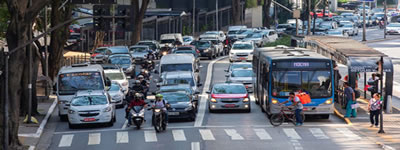An advanced traffic management system (TMS) is a context-aware technology that successfully coordinates traffic across city arteries by using real-time data from connected road infrastructure and predictive analytics. This traffic control software and urban wireless connectivity serve as the foundation for implementing an intelligent transportation management system. Today’s traffic management systems are under pressure to innovate and become leaner, greener, and more integrated. But what kind of technology is used to create such systems? In this article, we will discuss all you need to know about traffic management system.
What Is an Intelligent Traffic Management System?
An intelligent transportation system (ITS) is an advanced application that seeks to provide new services that relate to various types of transportation and traffic management. This will help users be better informed and use transportation networks in a safer, more coordinated, and “smarter” way. Some of these technologies include alerting emergency personnel in the event of an accident, deploying cameras to police traffic laws, and signs that indicate speed limit changes depending on the situation.
Although the term “advanced intelligent traffic system” can refer to any mode of transportation, the European Union directive 2010/40/EU defined an intelligent traffic system as a system in which information and communication technologies are used in the field of road transport, including infrastructure, vehicles, and users, as well as advanced traffic management and mobility management, as well as interfaces with other modes of transportation.
Furthermore, you can apply ITS to a variety of transport contexts (e.g., road transport, traffic management, mobility, etc.) to increase productivity and security. Furthermore, there has been a worldwide uptake of ITS technology to improve traffic flow and cut travel times.
How Do Traffic Management Systems Work?
Sensors, cameras, cellular routers, and automation are used in these systems to monitor and automatically divert traffic, reducing congestion.
Why Is Traffic System Important?
The primary purpose of traffic control systems is to protect the safety of persons nearby or in traffic. A road system with no traffic controls leads to more accidents and injuries.
What Are Traffic Control Systems?
Road Traffic Control Systems collect and analyze driving information from nearby vehicles. They also perform optimal traffic signal control in response to the constantly changing road traffic situation and provide useful traffic information to drivers through analysis of the data obtained. Ensuring smooth traffic flow by reducing vehicle driving time and the number of times vehicles come to a halt will result in benefits such as a reduction in road traffic accidents and a reduction in air pollution, which will contribute significantly to a safe and comfortable road traffic environment.
ITS enables more complex traffic control systems than standard timed traffic lights. Intelligent traffic lights are one control device that uses traffic data collected at the local intersection and future traffic information provided by RSUs to create a dynamic time schedule to maximize traffic flow through an intersection. Variable speed restrictions are another type of control mechanism. These systems work by dynamically adjusting the speed limits of roads based on weather, road conditions, or the presence of congestion regions to reduce traffic density in congested areas. Finally, because traffic in many metropolitan areas is not symmetrical, you can use dynamic lanes to provide more inbound or outbound lanes depending on the traffic flow.
What Are the Four Main Components of the Traffic Control System?
Primary components of the traffic system:
- Road users: this includes drivers, pedestrians, cyclists, and passengers, as well as private and commercial vehicles.
- Street and highways
- Traffic control equipment
- The general environment. The general environment influences traffic activities, but they are difficult to evaluate. Drivers and vehicles are beyond the control of traffic engineers, while roadway and traffic system design controls are important to their professional practice.
What Industry Is the Advanced Traffic Management System In?
Road traffic management is a logistics industry that deals with traffic from one location to another, arranging and monitoring it in the safest and most effective manner possible. One of the fundamental difficulties of highway traffic management is accommodating traffic in a safe and effective manner in order to reduce or eliminate crashes. There are various types of traffic management used on the highway, depending on its location, function, and length.
What Are the Principles of Traffic Management?
The principles of traffic management include:
- Agree on a road hierarchy on which to base future traffic management.
- Reduce the community’s exposure to traffic.
- Reduce the environmental impact of commercial vehicles.
- Ensure easy access to property and businesses.
- Make room for pedestrians and bikers.
- Create an intervention policy for the implementation of local area management programs.
- Ensure appropriate data is accessible to consider traffic management concerns properly.
- Make sure to conduct comprehensive consultation while assessing traffic management challenges.
- Offer low-cost traffic management systems.
- Increase access to commercial and recreational facilities while minimizing the impact on local people.
- Align the traffic management policy with the rest of the council’s policies.
- Create a foundation for future choices on pending traffic management challenges.
- Set up a system for regular policy reviews.
- Provide a mechanism for coordinating and facilitating the traffic control plan.
The Policy Aims to:
- Ensure adequate traffic flow and access into and through the Town of Cottesloe that maximizes road safety and local amenity.
- The establishment of a procedure for carrying out necessary traffic management works in a cost-effective and equitable way.
- Incorporation of the traffic management policy into the Strategic Plan of the Council
Why Is Traffic Management Important?
Roads, streets, and paths are an important part of our communities and are available to everyone. They allow us to move around in order to do what we want or need to accomplish in our lives. To guarantee that this occurs successfully and that traffic on these routes does not harm our communities, the entire system of travelers, vehicles, and travel routes must be carefully regulated. No one would argue against the notion that traffic signals, or traffic management signals, play a crucial role in keeping a large number of people safe. It benefits not only people who ride or drive in various modes of transportation, but also benefits pedestrians who cross the street every day.
Other Importance of Traffic Management Include
- Promoting the safety of passengers, drivers, and pedestrians.
- Maintaining the order of traffic movement at an intersection.
- It aids in the reduction of the frequency and severity of certain types of accidents.
- Because it instructs drivers and pedestrians when to go and when to halt, it helps keep traffic flowing smoothly. This helps keep things from coming to a dead stop on a daily basis.
- It also reduces the number of accidents and fatalities.
Recently, traffic signals have become unquestionably necessary due to their importance in our daily lives. Traffic control signals are increasingly being employed on construction and industrial sites where there is regular traffic movement. Besides the obvious applications on roads and highways, factories, and even grocery store checkout lanes can all benefit from the incorporation of Traffic Management signals.
In a factory setting, such signals typically contain two or more colors to represent the varying status, process, etc. Typical colors for a 2 status beacon are red/green or red/amber/green for a 3 status beacon. However, this is not set in stone. The signals and colors are frequently set in accordance with requirements from standards such as BS EN 842 and BS EN 981 but are ultimately determined by the end user’s application.
Bottom Line
I hope this article helped you to know to more about traffic management system.
Traffic Management System FAQs
What is traffic monitoring system?
A traffic monitoring system continuously and automatically observes vehicles in moving traffic. Sensors deployed on or near the road record, collect, assess, and show various parameters coming from cars, infrastructure, and the environment.
How do you manage traffic?
Measures aimed at reducing traffic congestion
- Improve traffic-light management.
- Monitor road conditions with CCTV.
- Enforce current traffic laws.
- Improve public impression of buses.
- Extend the parking zones for residents.
- Charge for parking at work.
- Improve the infrastructure for riding.
- Enhance bus services.
What are the types of traffic management?
Flagging, lane closures, detours, full highway closures, pedestrian access, traffic plans, traffic management vehicles, and sidewalk closures are all examples of traffic management.
Related Articles
- Best 27 Affiliate Marketing Courses To Try In 2022
- Refinancing loans: why is this an intelligent choice?
- SEO Software: 10 Best Free and Paid SEO Tools In 2022
- MARKETING STRATEGIES FOR ECOMMERCE BUSINESS
- LOGISTICS MANAGEMENT SYSTEM (LMS): Benefits and Elements






